Using the right type of cactus soil is extremely important, and it can be difficult to find the perfect mix. So I came up with my own simple recipe, and you only need 3 common ingredients to make it.
In this guide I’ll tell you everything you need to know about the best soil for your cactus. Including choosing which kind to use, and the specific properties to look for.
Then I’ll give you my DIY recipe and detailed instructions for how to make your own, step by step, as well as tips for properly storing the leftovers.
Trust me, the type you use really does matter! So you should either make your own with my recipe below, or buy a high quality brand. Read the package to find one with the following properties:
- Fast draining – Water should flow through quickly so it won’t retain moisture for very long. If the label says anything about being moisture retentive, then skip it.
- Gritty, sandy, or rocky – The medium should be made from a blend of non-organic materials like pumice, perlite, grit, small rocks, and sand. If it looks more like thick, rich dirt or compost, then it’s not the right choice.
- Porous or aerated – It should allow for air pockets between the particles so oxygen can easily reach the roots, instead of becoming compacted.
- Slightly acidic – Most cactus plants do best when the soil is a little acidic, or between 5 and 6.5 on a pH probe meter.
Related Post: How To Care For Cactus Plants
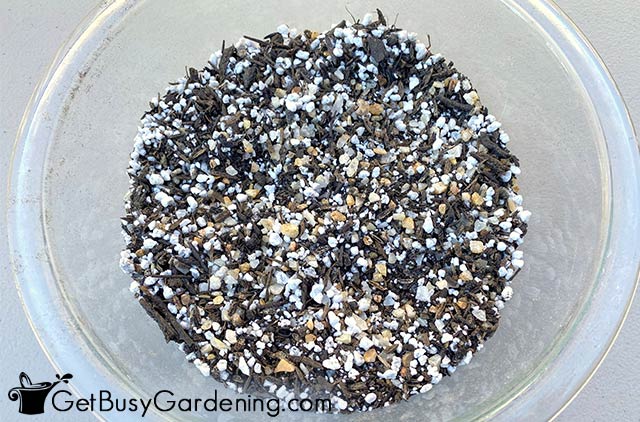
How To Make Cactus Soil Mix
It’s quick and easy to make your own cactus potting soil, and it’s usually cheaper than buying a pre-made mix.
Plus you have full control of what goes into it. So you can ensure it contains quality ingredients, and works the best for you and your plants. Here’s my recipe:
DIY Cactus Soil Mix Recipe
- 3 parts potting soil
- 3 parts coarse sand
- 1 part perlite or pumice *
* Use 2 parts perlite/pumice if you struggle with overwatering.
Ingredients
You only need 3 ingredients to make your own homemade cactus mix using my recipe: potting soil, coarse sand, and perlite. Below I’ll tell you about each one, and give you substitutions in case you can’t find them.
- Potting soil – This adds that small amount of organic material that we need for our mix. You can use a faster draining one if you tend to overwater. Avoid brands that say they retain moisture.
- Coarse sand – This helps to ensure that the cactus mix drains quickly. You can substitute turface or poultry grit. Some people like to use crushed granite or aquarium rock instead.
- Perlite – This adds drainage and aeration and also prevents compaction. If you can’t find it where you live, then you can use pumice instead, which is very similar.
Related Post: How To Water A CactusPlant
Supplies needed:
- Measuring container
- Trowel or shovel
- Container for mixing (I use a bucket or my table top potting tray)
- Dust mask (optional)
Steps For Making Your Homemade Cactus Soil
Step 1: Gather everything you need – Taking the time to gather and prepare all of your ingredients, tools, and supplies first will speed things up. Make sure your mixing container (I use a bucket or potting tray) is clean and dry.
Step 2: Measure the potting soil – Measure out 3 parts of your potting soil and pour it into your container.
You can use a one cup measure, a soil scoop, or a trowel for each part. It doesn’t matter what you use, just make sure it’s the same size for all of the ingredients.
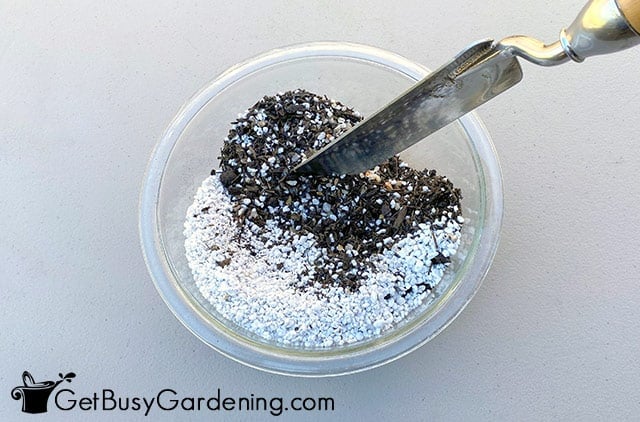
Step 3: Add sand – Add 3 parts coarse sand, turface and/or poultry grit. Stir it well so that everything is mixed up properly. You want to avoid large pockets of sand, so make sure to stir it thoroughly during this step.
Related Post: How To Save A Rotting Cactus From Dying
Step 4: Mix in the perlite – Last, add 1 part of the perlite or pumice. Then stir everything well so all of the ingredients are evenly distributed. If your DIY cactus soil is too dense or thick for your liking, add more perlite until it feels right.
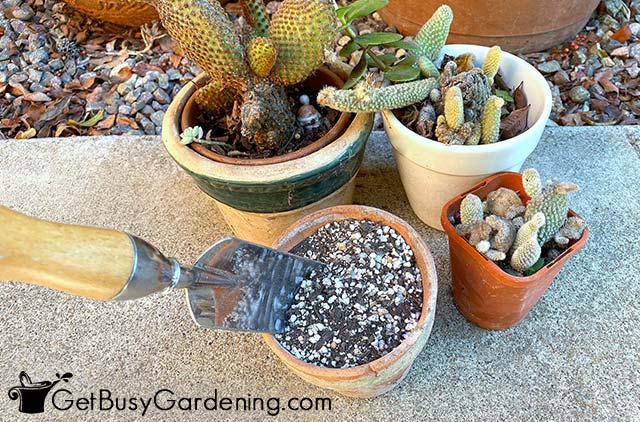
Storing The Leftovers
You can use your homemade cactus potting mix right away, or save it for later. I like to mix up a big batch and store the leftovers so I always have some on hand when I need it.
Simply put it into a five gallon bucket sealed with an airtight lid, and keep it in a dry location.
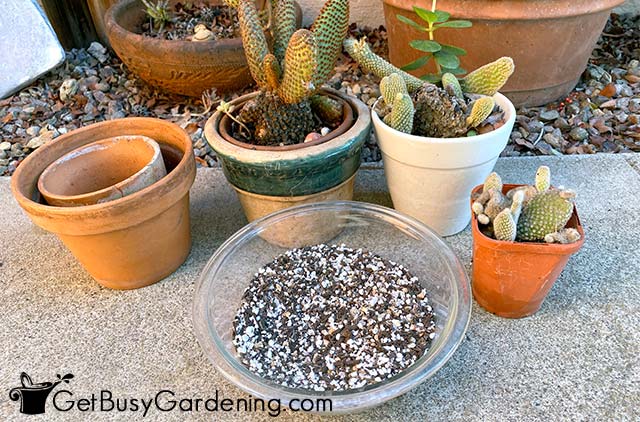
FAQs
Cactus soil is composed of a mixture of organic and porous materials. Some examples include sand, grit, perlite, pumice, peat moss, and pine bark.
I do not recommend using regular potting soil for your cactus plants. It holds way too much moisture, which can suffocate the roots and cause them to rot. Instead, you should add fast-draining amendments to it, or use a sandier mix.
If made correctly, cactus potting soil is not the same as it is for succulents. Cacti need a sandier and faster draining mix so they stay dry. Though, many people do use the same kind for both, I don’t recommend it, especially for beginners.
You should not use cactus soil for all of your plants. Since it’s designed specifically for desert plants, it will not retain enough moisture and doesn’t contain the right amount of organic materials and nutrients for most others.
Using a good quality cactus soil mix is very important for success. So, whether you choose to purchase it, or make your own with my recipe, you can find the perfect composition.
Share your favorite recipe or tips for how to make cactus soil in the comments section below.


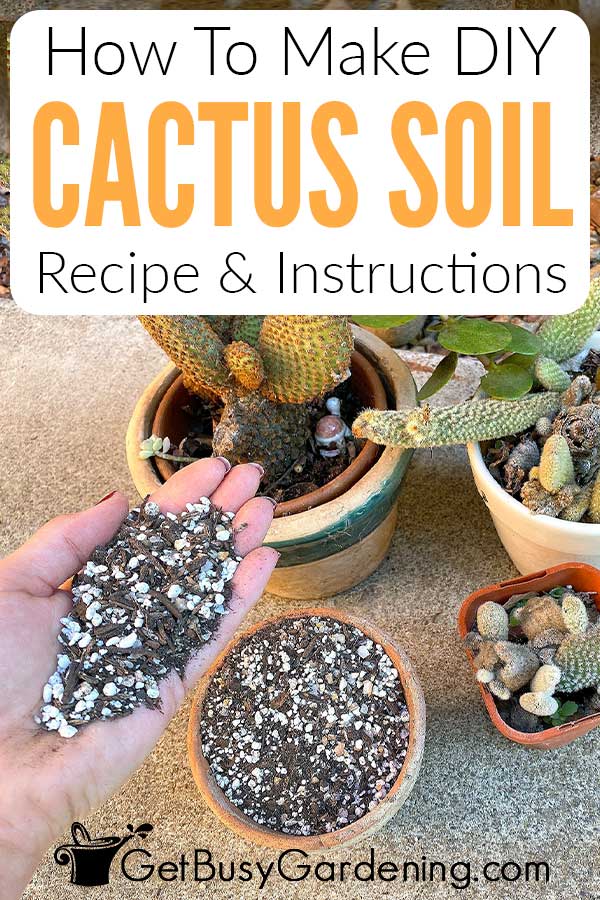
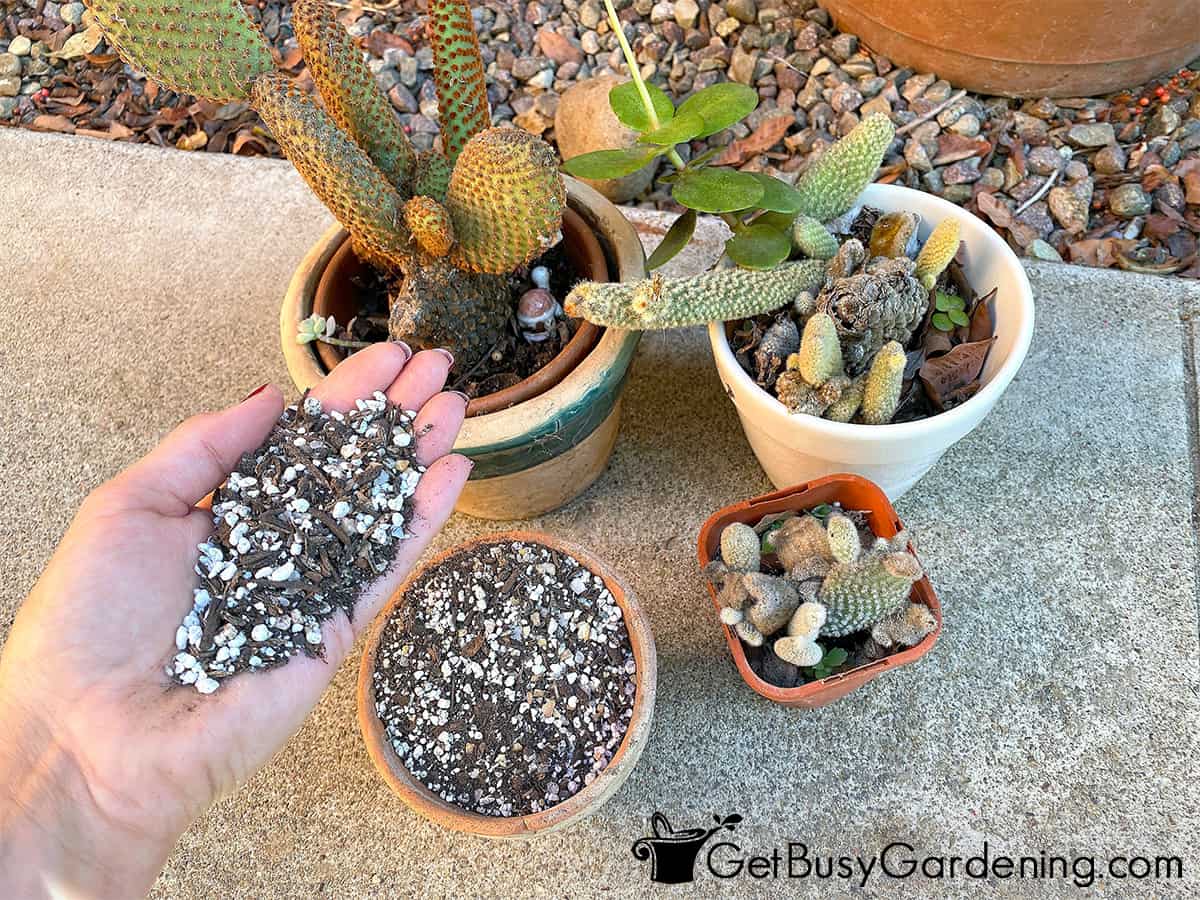


Tucson Connie says
I use this mix and my soil gets rock hard. What’s the issue?
Amy Andrychowicz says
Most likely you’re using the wrong type of sand. If it’s too fine, it will clump. Try a thicker/coarser grained one, or use turface or poultry grit instead. Also, make sure you’re using a good quality potting soil, rather than a cheap, heavy one, or topsoil.
Chance Smith says
I have a brand new Cactus and I’m not exactly sure what to do, it came with one of those fake flowers on it. And I ripped it off, and now the top of it is completely gone. Is it Beyond reparn or is it salvageable?
Amy Andrychowicz says
If by “fake flower” you mean you removed a grafted cactus from the top, then it shouldn’t kill the plant. But keep an eye on it to make sure it’s not rotting, that would be the biggest concern. Here’s more info about cactus rot, and how to save your plant if it’s happening.
Mishifu says
I think Chance may mean a dried straw flower that some places, like Home Depot glue on the top with a hot glue gun. I was fooled by one of these a few years ago.
Gypsy says
Can you use Quikrete coarse sand to add in the mix? It’s washed and graded coarse sand.
Amy Andrychowicz says
I’m not familiar with that specific brand, but any type of clean coarse sand should work for this.
Mercy says
Hi, Amy,
Thank you for sharing these DIY soil mixes. I use them for my successful and cacti now and they all love it.
A friend of mine left her Easter lily for me to plant sit and I tended it indoor. It was doing great for the first month but has slowly turned yellow and is slowly dying. How do I save it, please? Appreciate your help in this.
Amy Andrychowicz says
It’s normal for Easter lilies to die back after they’re done flowering. You can try keeping the bulbs and planting them in your garden or in pots for next year. I don’t have a specific post about how to do that, but here’s a general post about how to keep bulbs.
Fran says
My 4 inch tall family of cactuses has lost their green color in the bottom half. What causes this loss of green color on the bottom half of the cactus?
Amy Andrychowicz says
Some types of cactus plants naturally start to turn brown on the bottom as they age, it’s called corking. But unfortunately, it’s also a common symptom of rot due to overwatering. Here’s an article that will help… How To Save A Rotting, Dying Cactus.
Reba smith says
I have a cactus afield gave me who’s passing away so I want to keep it for that and because she started it from a 80 year old plant some of the plant is dry and ileaning down what do I do I’m afraid to replant it now thanks
Amy Andrychowicz says
It sounds like your cactus may have rot, here’s how you can try to safe it.